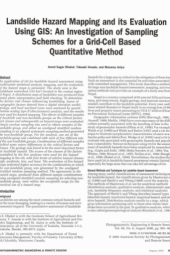Landslide Hazard Mapping and its Evaluation Using GIs: An Investigation of Sampling Schemes for a Grid-Cell Based Quantitative Method
Summary
The study used GIS for landslide hazard assessment in the Kulekhani watershed of Nepal (124 km2). A distribution map of landslides was created from aerial photos and field checks. Topographic, geological, and land use/land cover data were analyzed to identify factors influencing landslides. Geology emerged as the most crucial factor. Hazard maps were generated in GIS with four relative hazard classes. The evaluation of five hazard maps showed higher accuracy when using unaligned stratified random sampling for the non-landslide group. The hazard maps produced with this method were practical for use.
Categories:
Journal, Report
Publisher:
Photogrammetric Engineering & Remote Sensing
Published Year:
2000
